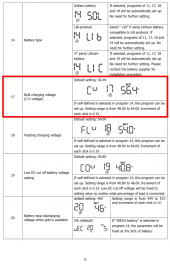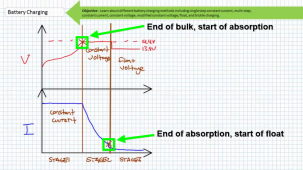alejnavab
New Member
- Joined
- Aug 6, 2022
- Messages
- 5
I have an inverter, brand MPP Solar, model LVX 6048. It is a hybrid inverter, as in having an AC input, AC output, PV input, and battery input/output. I'm using it with lithium batteries. On the manual, it says the program (setting) #17 is the “bulk charging voltage”, as shown in the screenshot below. Here is the user manual.

I would like to know what does that mean.
I'm using the inverter with lithium batteries, so I've already set program/setting #14 (battery type) to USE (user-defined), so that I can adjust the value of program #17.
I know that the (re)charge cycle/process of a secondary/rechargeable battery consists of a bulk stage, absorption stage, float stage, and optionally an equalization stage once every 1-6 months. The bulk charging stage of a battery is done at constant current while the voltage increases from its current SoC (state of charge) to about 70%-80% of its full charge. In other words, the battery voltage is not constant during this stage. Hence, I don't think the “bulk charging voltage” setting of the previous inverter refers to the voltage to be supplied to the battery, because it is in reality varying as the batteries charges more and more.
But I think it may refer to the voltage at which the bulk stage ends (and so the absorption stage begins). Is this the case? If not, what does the "bulk charging voltage" mean?

I would like to know what does that mean.
I'm using the inverter with lithium batteries, so I've already set program/setting #14 (battery type) to USE (user-defined), so that I can adjust the value of program #17.
I know that the (re)charge cycle/process of a secondary/rechargeable battery consists of a bulk stage, absorption stage, float stage, and optionally an equalization stage once every 1-6 months. The bulk charging stage of a battery is done at constant current while the voltage increases from its current SoC (state of charge) to about 70%-80% of its full charge. In other words, the battery voltage is not constant during this stage. Hence, I don't think the “bulk charging voltage” setting of the previous inverter refers to the voltage to be supplied to the battery, because it is in reality varying as the batteries charges more and more.
But I think it may refer to the voltage at which the bulk stage ends (and so the absorption stage begins). Is this the case? If not, what does the "bulk charging voltage" mean?
Last edited:



